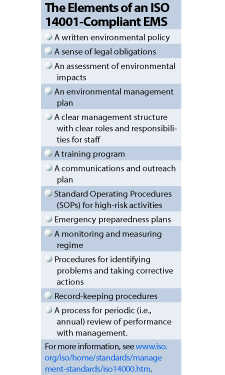 Smack-dab in the middle of America might not seem to be the most likely place to find community-level sustainability in action, but it is in the City of Leawood, Kansas. The community of slightly more than 30,000 residents is proactively working to reduce its environmental footprint. The City has a Sustainability Advisory Board. They have a robust recycling program. The Leawood Parks and Recreation Department is leading the City in the development of a “green mobility” plan to promote walking and cycling. And, recently, the City golf course became one of the first municipal courses in the United States to utilize an Environmental Management System (EMS) for enhanced conservation and stewardship.
Smack-dab in the middle of America might not seem to be the most likely place to find community-level sustainability in action, but it is in the City of Leawood, Kansas. The community of slightly more than 30,000 residents is proactively working to reduce its environmental footprint. The City has a Sustainability Advisory Board. They have a robust recycling program. The Leawood Parks and Recreation Department is leading the City in the development of a “green mobility” plan to promote walking and cycling. And, recently, the City golf course became one of the first municipal courses in the United States to utilize an Environmental Management System (EMS) for enhanced conservation and stewardship.
Unlike most in the golf industry, Ironhorse Golf Club in Leawood, managed by Troon Golf, is not new to EMS. A number of years ago, Troon Golf made a corporate commitment to make use of an EMS (e-par EMS for Golf) at each of the 100-plus facilities the company manages. For Ironhorse Golf Club and the City, this move made sense. As Golf Course Superintendent James Kennedy says, “The EMS fit in well with the environmentally focused mission statement the City had set.”
What Is an Environmental Management System?
An Environmental Management System is a framework for managing environmental obligations and expectations that relies on a “plan-do-check-act” approach. The basic elements of an EMS include the following:
- Setting the business’s environmental goals
- An assessment of environmental impacts, legal requirements and any other voluntary standards
- Setting objectives and targets to address risks, legal requirements and voluntary/industry standards
- Establishing programs and best management practices to meet these objectives and targets
- Monitoring and measuring progress on environmental management goals
- Ensuring employees’ environmental awareness and competence through training
- Reviewing progress of the EMS and making improvements periodically (i.e., annually).
It’s surprising that more park departments haven’t done what the City of Leawood has done. For more than a decade, the U.S. Environmental Protection Agency (EPA) and other state regulatory agencies have been advocating that organizations of all types adopt EMSs:
“An Environmental Management System helps a company address its regulatory demands in a systematic and cost-effective manner. This proactive approach can help reduce the risk of noncompliance and improve health and safety practices for employees and the public. An EMS can also help address nonregulated issues, such as energy conservation, and can promote stronger operational control and employee stewardship” (Source: www.epa.gov).
In particular, the EPA and many other state environmental agencies have leaned toward the use of ISO 14001-compliant EMSs — an internationally-recognized environmental management standard used by hundreds of thousands of organizations worldwide. The ISO 14001 standard drives organizations, like Ironhorse Golf Club, to develop a set of specific elements in their environmental management plan (see box).

Framework… With Benefits
Like so many other organizations around the word that have adopted the EMS approach, Ironhorse Golf Club is seeing the benefits of this systematic approach to environmental stewardship. As Kennedy says, “After completing the first phase of the [e-par EMS] program, I believe having the Standard Operating Procedures for training purposes will be beneficial. It will give our staff an understanding of the potential environmental impacts and know how to avoid or correct them. Likewise, the checklists the EMS provides have delivered insight into items you may not necessarily think of managing. Plus, if there are activities that could be high-risk for negatively impacting the environment, we can use the information collected through EMS use as a tool to help request funding to resolve those issues.”
Consider that the EPA reports more than 1,000 golf operations were subject to some level of regulatory violation during the past three years, and it’s easy to see why an EMS can add value — along with peace of mind — to golf course maintenance operations.
It’s not just for golf operations either. Park and recreation departments of all sizes across the country are starting to take advantage of the value an EMS can bring. For example, when the City of Charlottesville in Virginia looked to develop a city-wide EMS in 2003, it was the Department of Parks and Recreation that was selected to lead the way. This included the City’s Meadow Creek Golf Club. Just as at Ironhorse Golf Club, the EMS framework was found to be effective and worthy of adopting department-wide. As Kristel Riddervold and Dan Frisbee of the City of Charlottesville’s Public Works Department stated in a 2006 case study after the EMS was implemented at Meadow Creek, “The EMS has allowed us to make the most of various pollution prevention techniques and best-management practices by orienting them in a systematic, practical and accountable fashion. It is important to emphasize that the EMS model incorporates ‘continual improvement,’ which helps the golf course, department and City achieve their goal of environmental sustainability. Overall, the EMS has been a valuable tool to achieve positive change and has provided a vehicle to educate and engage staff at all levels in our environmental stewardship efforts.”
Those same results now resonate throughout the entire Charlottesville Parks Department, and Charlottesville is not alone. Parks and recreation departments across the country, from Seattle to Newport News, are beginning to see the value in using EMSs to ensure compliance, reduce risk and drive environmental excellence, with many, like the City of Leawood, relying on the well-established ISO 14001 EMS standard.
In the end, the EMS framework is a simple and organized tool that can help park professionals become leaders on environmental stewardship efforts in their communities, working in concert with established and ongoing environmental initiatives. As Chris Claxton, Leawood’s parks and recreation department director, puts it, “Under the umbrella of the Parks and Recreation Department, the City established a Sustainability Advisory Board in 2010 in order to work with its citizens to make Leawood a more environmentally friendly community. This recent initiative by the Troon Staff at Ironhorse is just one more simple, yet important way Leawood continues its commitment to environmental stewardship.” Systematically!
Kevin A. Fletcher, Ph.D., is President and CEO of e-par USA Inc.

